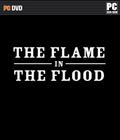Survival games have been around for a long time. Many gamers have partaken in the genre unknowingly via The Oregon Trail, and the genre has been in a renaissance lately thanks to games like DayZ, Minecraft and Sheltered sparking interest in overcoming every terrible odd thrown against you. At first glance, the art style of The Flame in the Flood may make it seem like a long-lost cousin of Don't Starve. It doesn't take long to discover that the game has its own identity in a genre that has quickly become crowded on the PC.
You play the role of Scout, a woman trying to survive in the postapocalyptic American Midwest, where the waters have taken over and turned the high grounds into islands. You befriend a dog named Aesop, who brings you new supplies by way of a backpack. Inside the backpack, you find a radio that works and picks up a broadcast. Curious, you and your new dog hop aboard a raft and try to locate the source of the signal — and hopefully a place of more permanent refuge.
The game hits all of the genre hallmarks. Your survival depends on your maintenance of four meters: hunger, sleep, temperature and thirst. You keep up those four meters in the usual ways, like eating food, drinking clean water, sitting by a fire, or taking a nap in a church or abandoned school bus. With the help of your canine friend, you can gather things you find in the world and craft items. Aside from worrying about wild animals, other hazards like fire ants, poison ivy, and contaminated food and water result in you getting injured or sick; if you don't take care of it immediately, it can develop into something worse.
You are pretty limited in some ways when compared to other survival games. For starters, you can't really fight back. You can shoo away crows in hopes of preventing them from calling in other animals, but unless you get yourself a bow and some arrows, your only course of action is to run. Also, you can't craft any form of safe shelter. You can sleep by campfires, but they'll go out if it rains, and that also exposes you to other predators. Finally, your backpack can only carry so many different items at one time, and unless you find a way to expand its space, you can only rely on Aesop to carry some extra equipment for you.
There are a few things that work in your favor, though. For example, Aesop cannot be killed, so there's no need to worry about him when you're trying to prevent a boar from breaking your leg. You can create traps that snag some bunnies to eat, but you can also turn the table on your predators. If you're lucky, you can even have the animals turn against one another and wait to see if you can pick up the spoils. Your crafting system is more streamlined, as all of your crafting recipes are immediately visible and the act of crafting requires you to hold down a button to create the item instead of meticulously grabbing each ingredient one at a time.
The game's hook comes from the raft and the river. The raft serves as both the only means of going down the river as well as extra storage compartment. It is functional enough but can be improved, transforming it from something unwieldy to a powerful craft that can take you almost anywhere. In a way, it is compensation for the fact that you can't build any solid structures of your own. It also happens to be rather fragile, and unless you repair it often or try to ensure you aren't crashing all over the place, you will die in the water. As for the river, the currents can guide you anywhere while the rapids force you down an unstable obstacle course where fallen trees and floating cars will suddenly get in your way. You'll either have the reflexes to deftly move out of the way, or you'll take the hit and hope it isn't too severe.
The river also gives you a sense of constant momentum. There are only so many items in each land, and it doesn't take long for you to grab what you need before moving on. The rush of the waters, both in their calm and rapid state, gives you moments to decide where you'll head, and there's no way to go against the current, even if you craft the most powerful raft. You will have to skip one outpost in favor of another, whether you like it or not, and if you miss out on doing something important, you have to hope that another opportunity pops up later down the river. That kind of approach to the genre is refreshing, as it means less time trying to prepare and more time acting.
The Flame in the Flood does so much right in terms of lessening the slog associated with the genre and streamlining parts of the experience that it's rather noticeable when it does something wrong. In this case, it would be with inventory management in relation to crafting. For some reason, you aren't allowed to craft an item if you have a full inventory, even if the crafting will free up space. It becomes annoying to juggle items between yourself, Aesop and the raft, and since the game doesn't pause when you're doing this, you're needlessly wasting points on your survival bar.
The game features two modes, but there isn't much difference between them. Endless mode has you going down the river and trying to survive for as long as possible until you expire. Campaign mode limits the experience to 10 stages and sets you on the task to find the radio signal that put you on this journey in the first place. It also gives you the option to continue from your last checkpoint, so you can try to complete the story. In both cases, your next playthrough can be bolstered by having Aesop transport items in his storage between runs. Also, the runs are randomized, so depending on how bad your luck is, you might stand a better chance starting from scratch if you're injured early in the campaign. The only flaw is that the game can only have one save file at a time; for some reason, starting off an Endless game erases any progress made on a Campaign.
The graphics are a mash-up of styles that's reminiscent of other games and properties. You're reminded a little of Don't Starve thanks to some of the angular elements and Psychonauts in how that style translates into polygonal form. The facial features of the characters you meet, particularly the eyes, make things look rather creepy, especially if Scout is injured and you see extra features on the portrait. The rest of the environments have a flatter color gradient than expected from a polygonal title, but the use of effects like rain and lighting make it feel more real than other titles in the genre.
Devoid of voices, the other two elements that comprise the audio do a great job of bestowing the game with character. The effects help greatly with the atmosphere; the loud rush of water by any of the docks is both frightening and exhilarating, while the other sounds of nature remind you of what the catastrophe has left behind. There's a good sense of awe of the environment, despite the constant danger that it throws at you. Meanwhile, the soundtrack highlighted by Chuck Ragan is perfect for the world. Whether it's the country twanging of a banjo or a full-on folk ballad, the tracks balance out the inherent dangers of the world by providing calming material — even when you're about to be mauled by a bear. If anything, the soundtrack is so good that you'll also want to listen to it outside of the game.
The Flame in the Flood delivers a brilliant twist on the survival genre. The inability to linger in one place makes the game feel like a proper adventure with some additional survival trappings. The randomization gives it a roguelike feel, and the streamlining of elements makes it feel fair even when almost everything is working against you. Coupled with a beautiful presentation throughout, it's both a high-water mark in the genre and a title that's worth trying out. Unless you absolutely hate the survival game genre, be sure to check out The Flame in the Flood.
Score: 9.0/10
More articles about The Flame in the Flood











 The Flame in the Flood is a rogue-lite river journey through the backwaters of a forgotten post-societal America where you forage, craft, and evade predators.
The Flame in the Flood is a rogue-lite river journey through the backwaters of a forgotten post-societal America where you forage, craft, and evade predators.


















